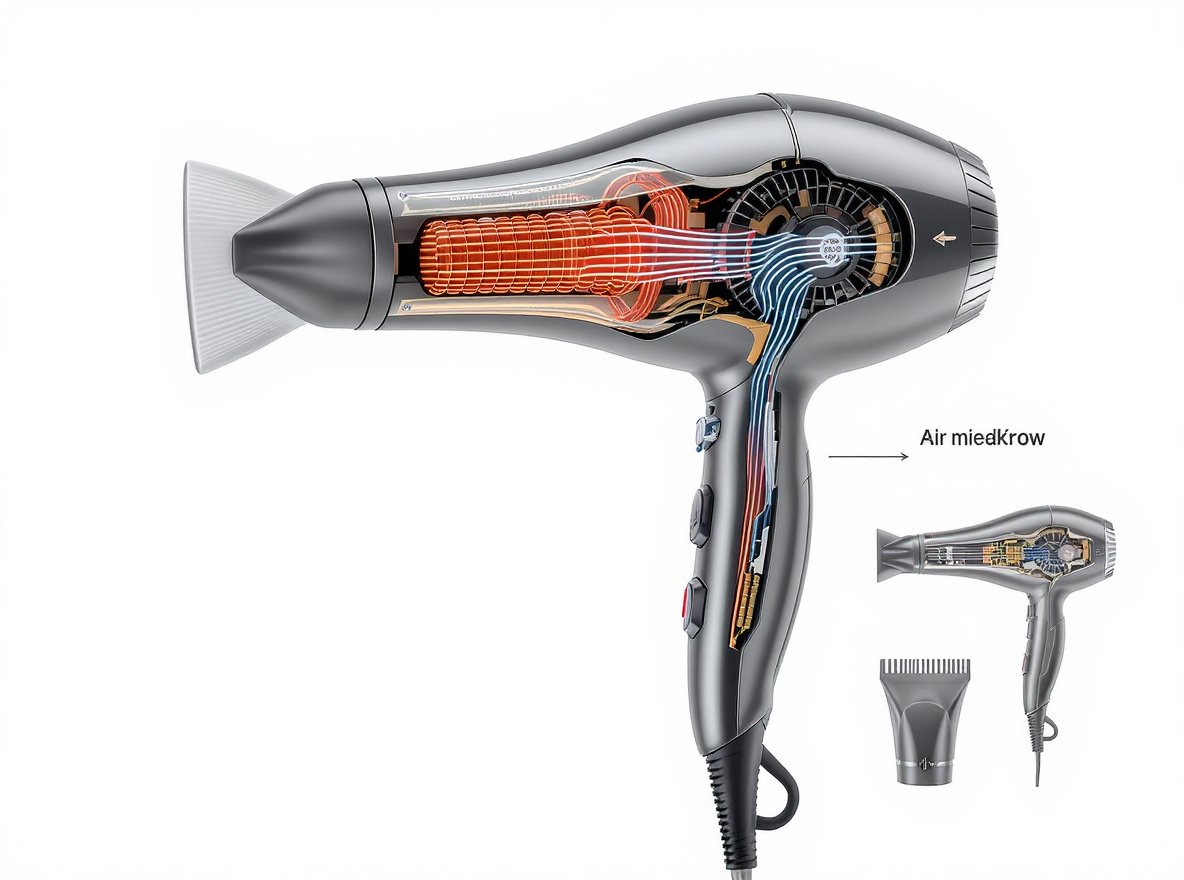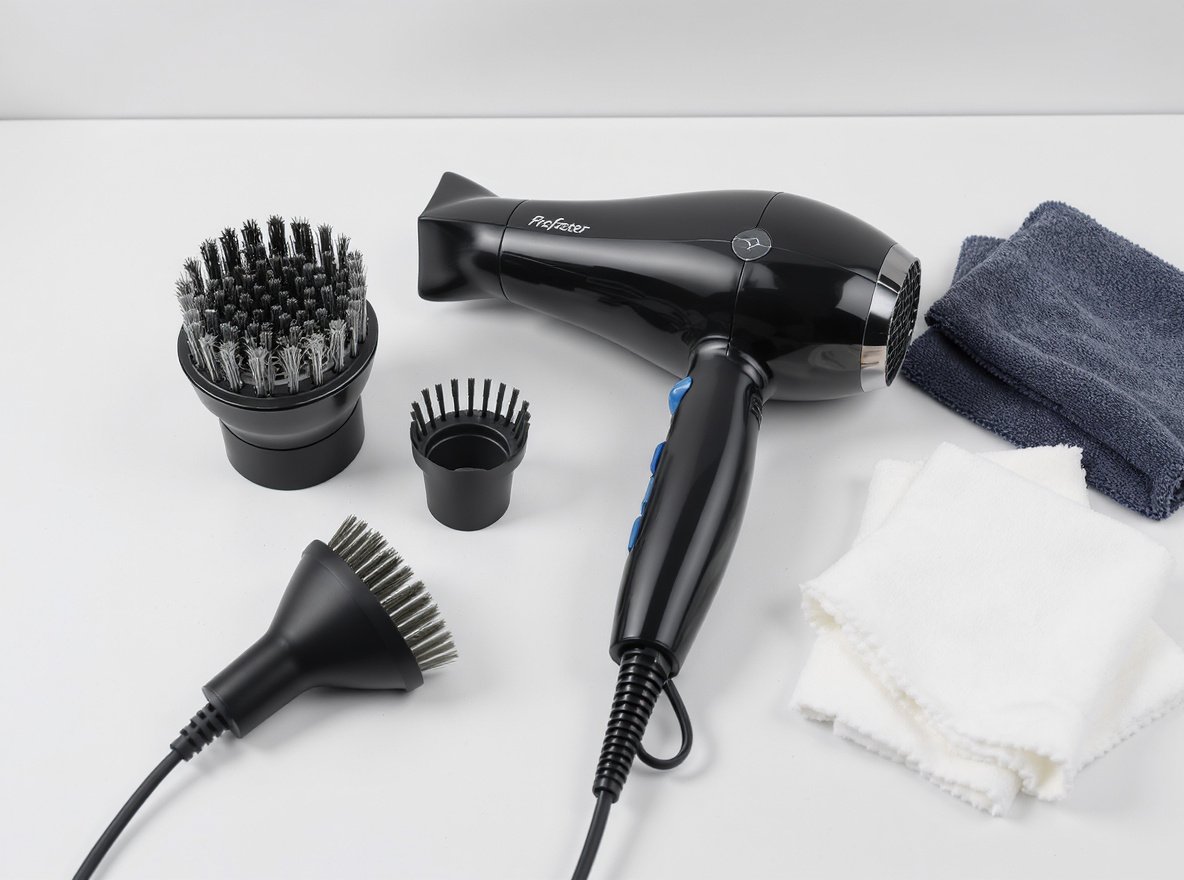When shopping for professional hair dryers, you’ll encounter two crucial specifications that often confuse buyers: air speed measured in meters per second (m/s) and air volume measured in cubic feet per minute (CFM). Understanding these differences can make or break your drying performance and customer satisfaction.
Air speed (m/s) measures how fast individual air particles move from the dryer’s motor, while air volume (CFM) measures the total amount of air being moved per minute. Air speed determines penetration power and styling precision, whereas CFM indicates overall drying capacity and efficiency. Professional dryers require both high air speed (35+ m/s) and adequate CFM (40+ CFM) for optimal performance.
Let’s dive deeper into these critical specifications and discover how they impact your hair drying business.
Table of Contents
ToggleWhy Do Air Speed and CFM Matter for Professional Hair Dryers?
Understanding these measurements is crucial for any business selling or using professional hair dryers. Your customers expect fast, efficient drying that doesn’t damage hair or waste time in salon settings.
Professional hair dryers require both high air speed for precision styling and adequate CFM for efficient moisture removal. The combination determines drying time, hair health, and overall client satisfaction in commercial environments.
Air speed affects how deeply the airflow penetrates hair layers and how precisely you can direct the airflow for styling work. Higher speeds create focused streams that work well for smoothing and detailed styling techniques.
Meanwhile, CFM determines how much moisture the dryer can actually remove from hair in a given time. Professional dryers prioritize higher CFM ratings because volume airflow reduces overall drying time more effectively than speed alone.
The relationship between these factors creates the overall drying experience. Professional stylists need precision for detailed work, while busy salons need volume for quick client turnover throughout long working days.
What Exactly Is Air Speed (m/s) in Hair Dryers?
Air speed represents how fast air particles are being pushed by the motor, measured in meters per second. This specification directly impacts styling precision and hair penetration power.
Air speed in hair dryers ranges from 18-25 m/s for budget models up to 42 m/s for high-end professional units. Modern high-speed dryers with brushless motors operating at 100,000-110,000 RPM can achieve impressive velocities that significantly outperform traditional models.
Think of air speed as the “velocity” of your airflow. Current market performance shows:
• Budget dryers: 18-25 m/s – suitable for basic home use
• Mid-range models: 19-25 m/s (examples: Laifen SE Lite at 19 m/s, Tideway H11 at 25 m/s)
• Professional high-speed dryers: 35-42 m/s for salon environments
• Premium models: Dyson Supersonic delivers 88 mph (approximately 39 m/s)
Higher air speeds create more penetrating power to move moisture away from hair strands while minimizing heat exposure time, protecting hair health during styling.
| Air Speed Range | Performance Level | Typical Applications | Motor Technology |
|---|---|---|---|
| 18-25 m/s | Budget/Consumer | Home use, light styling | Traditional AC motors |
| 25-35 m/s | Mid-Range | Semi-professional use | Enhanced motor design |
| 35-42 m/s | Professional | Salon use, all hair types | Brushless, 100,000+ RPM |
The motor speed directly influences air velocity, with high-speed brushless motors generating significantly faster airflow than traditional motor designs.
What Does CFM Mean for Hair Dryer Performance?
CFM stands for Cubic Feet per Minute, measuring the total volume of air a hair dryer moves through its system. This specification takes into account both air speed and the cross-sectional area through which airflow passes.
Professional hair dryers typically deliver CFM ratings between 27-65, with consumer models ranging from 10-20 CFM. Higher CFM provides greater overall air volume to cover more surface area simultaneously, making it crucial for efficient moisture removal.
Current market data reveals specific performance tiers:
Consumer Models: 10-20 CFM range for personal use
Professional Dryers: 27-65 CFM for salon environments
• Dyson Supersonic: 27.5 CFM
• Parlux models: 41-46 CFM
• Turbo Power models: 41-46 CFM
• High-performance units: Up to 63.8 CFM (Goody Flash Dry)
CFM determines your dryer’s “breathing capacity” and affects:
• Overall drying time for complete hair sections
• Performance consistency across different hair densities
• Motor efficiency and longevity under commercial use
• Heat distribution throughout the airflow pattern
Interestingly, velocity dryers used in professional pet grooming can exceed 300 CFM, demonstrating the potential for much higher volumes when specialized applications require it.
How Do Air Speed and CFM Work Together?
Air speed and CFM work synergistically to create optimal hair drying performance. A dryer can have high air speed but lower CFM if the outlet is narrow, or high CFM with moderate air speed if it has a wider airflow path.
The synergy between air speed and CFM determines overall drying effectiveness. Higher air speed creates more penetrating power, while higher CFM provides greater air volume to cover surface area simultaneously. Professional dryers optimize both parameters through advanced engineering.
Professional considerations include:
Nozzle Design Impact
Concentrator attachments increase air speed by narrowing the outlet while maintaining CFM, allowing stylists to focus powerful airflow precisely where needed.
Motor Technology Integration
Brushless motors at 100,000+ RPM generate both high velocity and substantial volume, with advanced designs like Dyson’s digital motor V9 balancing speed and volume for optimal performance.
Airflow Engineering
Professional dryers use sophisticated airflow paths to maximize both metrics without compromising either specification.
| Combination Type | Benefits | Best Applications | Professional Use |
|---|---|---|---|
| High Speed + High CFM | Maximum performance | Thick/coarse hair, time-sensitive styling | Premium salon services |
| High Speed + Moderate CFM | Precision with efficiency | Detail work, fine hair protection | Specialized styling techniques |
| Moderate Speed + High CFM | Gentle volume drying | Damaged hair, curl preservation | Corrective treatments |
The most effective professional approach combines high CFM with moderate heat settings, allowing increased air volume to do primary drying work while minimizing thermal damage.
Which Specification Matters More for Different Hair Types?
Different hair types respond optimally to specific combinations of air speed and CFM, making specification priorities crucial for customer satisfaction and professional results.
Fine hair requires moderate air speed with controlled CFM to prevent damage, while thick hair needs both high air speed (35+ m/s) and strong CFM (40+ CFM) for efficient penetration and moisture removal.
Research-based recommendations by hair type:
Fine/Thin Hair
• Recommended specs: Lower wattage (1400-1600W), moderate air speed
• Optimal approach: Gentler airflow to prevent damage while maintaining efficiency
• Key consideration: Fine hair (0.05mm diameter) is more fragile and requires careful heat management
Thick/Coarse Hair
• Recommended specs: Higher wattage (1800-2000W+), strong CFM (40+ CFM)
• Optimal approach: High air volume to penetrate dense hair structure efficiently
• Key consideration: Thick hair holds more moisture, requiring substantial airflow to reduce drying time
Curly/Textured Hair
• Recommended specs: Balanced air speed with diffuser attachments
• Optimal approach: Controlled airflow to preserve curl pattern while reducing frizz
• Key consideration: Requires gentle, distributed airflow rather than concentrated high-speed jets
The key insight: hair density determines CFM needs, while hair fragility determines optimal air speed requirements for safe, effective styling.
What Are the Current Professional Hair Dryer Specifications?
Industry standards have evolved significantly with modern motor technology, establishing clear performance benchmarks for professional environments.
Professional salon dryers typically feature 35+ m/s air speed, 45+ CFM air volume, 2000W+ power, and 2000+ hour motor life. These specifications ensure consistent performance across diverse hair types during extended commercial use.
Current professional standards show:
| Specification | Consumer Range | Professional Standard | Premium Professional |
|---|---|---|---|
| Wattage | 1200-1600W | 1875-2400W | 2000W+ preferred |
| Air Speed | 18-25 m/s | 35+ m/s | 42 m/s maximum |
| CFM | 10-20 CFM | 40-65 CFM | 45+ CFM recommended |
| Motor Life | 500-1000 hours | 2000-3000 hours | 2000+ hours minimum |
Professional dryers prioritize higher CFM ratings because volume airflow reduces overall drying time more effectively than speed alone. Salon environments require consistent, powerful airflow to handle diverse hair types efficiently throughout demanding work schedules.
Modern brushless motor technology enables these performance levels while maintaining reliability, with some units operating at 100,000-110,000 RPM to achieve optimal air speed and volume combinations.
How Do These Specifications Affect Drying Time and Energy Efficiency?
The combination of air speed and CFM significantly impacts both operational efficiency and energy consumption, directly affecting your business’s profitability and service capacity.
High CFM reduces drying time by 50-70% compared to basic models, while faster air speed minimizes heat exposure time. Professional-grade airflow can cut styling time from 15-20 minutes to 3-10 minutes, dramatically increasing service capacity.
Performance benefits include:
Dramatic Time Savings
Professional dryers with optimized specifications allow stylists to complete more clients daily, with some high-performance models reducing average drying sessions by over half.
Energy Efficiency Considerations
Increased airflow efficiency reduces reliance on high heat settings, potentially lowering energy consumption per styling session despite more powerful motors.
Operational Advantages
More powerful motors may use more electricity initially but complete drying faster, potentially reducing overall energy use while improving client throughput.
The most efficient approach combines high CFM with moderate heat settings, allowing the increased air volume to handle primary moisture removal while minimizing thermal damage risks.
| Performance Metric | Standard Dryer | Professional High-CFM | Business Impact |
|---|---|---|---|
| Average drying time | 15-20 minutes | 3-10 minutes | 2-3x more clients/day |
| Heat requirement | High temperatures needed | Moderate heat sufficient | Reduced hair damage risk |
| Energy per session | Higher due to longer use | Lower due to faster completion | Improved cost efficiency |
Professional dryers with 2000W+ power deliver better results per unit of energy consumed compared to underpowered alternatives, making them more cost-effective for commercial applications.
Summary
Air speed (m/s) and CFM serve complementary roles in professional hair dryer performance. Air speed (35+ m/s for professional use) determines penetration and precision, while CFM (40+ CFM for salon applications) provides the volume needed for efficient moisture removal. Modern professional dryers combine both specifications with advanced brushless motor technology to deliver superior results across all hair types.
Ready to upgrade your hair dryer inventory with specifications that deliver professional results? Explore our P1C high-speed hair dryer featuring advanced motor technology and optimized airflow specifications, or browse our complete professional hair dryer collection. Contact us today for wholesale pricing and detailed technical specifications that will help your business thrive in competitive markets.











